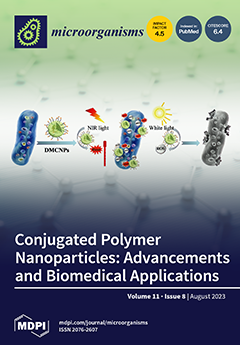The fall armyworm,
Spodoptera frugiperda (Lepidoptera: Noctuidae), is a polyphagous pest highly damaging to maize and other food crops in Africa, particularly in Côte d’Ivoire. Chemical pesticides not only have often proved to be unsuccessful, but cause adverse effects on the environment and
[...] Read more.
The fall armyworm,
Spodoptera frugiperda (Lepidoptera: Noctuidae), is a polyphagous pest highly damaging to maize and other food crops in Africa, particularly in Côte d’Ivoire. Chemical pesticides not only have often proved to be unsuccessful, but cause adverse effects on the environment and human health; therefore, entomopathogenic fungi could represent an alternative biocontrol solution. Against this background, fungi were isolated from soil samples collected in maize fields in three regions of Côte d’Ivoire, by the methods of soil dilution and baiting with
Galleria mellonella. The resulting 86 fungal isolates were phenotypically and genetically identified. The pathogenicity of seven isolates of
Metarhizium spp., three isolates of
Beauveria bassiana and two isolates of
Trichoderma sp. was evaluated on fifth instar larvae (L5) of
G. mellonella. Larval mortality rates and the median lethal time (LT
50) were determined seven days after inoculation for each of these selected isolates. The median lethal concentration (LC
50) was determined for a selection of isolates.
Beauveria bassiana isolate A214b was the most effective, causing 100% mortality, with an LT
50 of 2.64 days and an LC
50 of 1.12 × 10
4 conidia mL
−1. Two other promising isolates, A211 and A214a, belonging to
B. bassiana, caused 100% mortality with LT
50 values of 3.44 and 4.04 days, respectively. Mortality caused by
Metarhizium isolates varied from 65.38% to 100%, with
Metarhizium anisopliae isolate T331 causing 100% mortality with an LT
50 of 3.08 days at an LC
50 of 3.33 × 10
4 conidia mL
−1.
Trichoderma sp. isolates were the least pathogenic ones.
Beauveria bassiana and
Metarhizium isolates showed to be virulent against the model Lepidopteran
G. mellonella and will be tested on
S. frugiperda.
Full article






